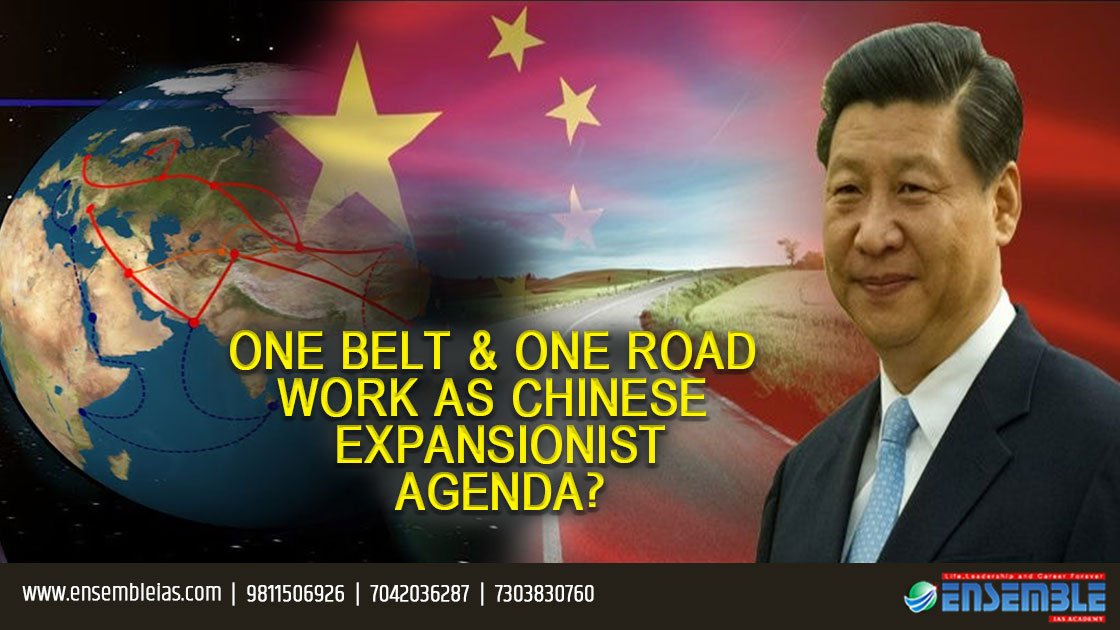What are the costs involved in One Belt and One Road (OBOR) and which regions of the world do the project aims to connect?
The one belt one road is an ambitious initiative that envisages laying the infrastructure and connectivity networks for economic progress in as many as sixty countries of the world with a proposed investment of 4 to 8 trillion US dollars from the participating nations.
The land-based Belt and Road project – Silk Road Economic Belt” (SREB) – is to be divided and carved into six corridors while the maritime silk road connects regions along one route stretching from the Chinese Coast over Singapore and India to the Mediterranean.The land-based component of the whole project covers the following six routes/regions –

- China–Pakistan Corridor, running from South-Western China to Pakistan
- Bangladesh–China–India–Myanmar Corridor, running from Southern China to India
- New Eurasian Land Bridge, running from Western China to Western Russia
- China–Mongolia–Russia Corridor, running from Northern China to Eastern Russia
- China–Central Asia–West Asia Corridor, running from Western China to Turkey
- China–Indochina Peninsula Corridor, running from Southern China to Singapore
What geopolitical and diplomatic benefits China and other member nations expect from OBOR?
 China expects to reap huge diplomatic and economic benefits as the OBOR will establish direct road and rail corridors between East Asia and Europe, in addition to a string of seaports linking China with Southeast Asia, South Asia, Africa, the Middle East and Europe.
China expects to reap huge diplomatic and economic benefits as the OBOR will establish direct road and rail corridors between East Asia and Europe, in addition to a string of seaports linking China with Southeast Asia, South Asia, Africa, the Middle East and Europe.
The project will work as a catalyst and stimulant for the economic growth and prosperity amongst Eurasian countries. It is because of the Chinese intentions to expand the canvas of cooperation that Asian Infrastructure Investment Bank (AIIB) has been made the investment arm of the OBOR policy.
Through the OBOR Project, China has made it crystal clear that it wants to remove regional disparities by triggering the process of intense partnership and addressing the development issues in the right perspective. This is one side of the benefits –economic in nature- which will accrue to member nations.
The other side of the advantages is purely diplomatic and is related to the refurbishing of the Chinese image as the nation who cares and helps which has been, otherwise, missing in global political and diplomatic circles as China has earned a notorious image for existing territorial disputes with its neighbors.
The issue of Tibet and India is a case in point in which China is blamed to infringe upon territorial integrity of India and more often cast an evil eye on the integral parts of India. Chinese policymakers, through OBOR , are restless in projecting a messiah image of China so as to wash the blots off Chinese hard and uncooperative images.
One Belt and One Road Elucidate on historical significance of one belt one road OBOR?
 The one belt, one road initiative carries great historical significance, as through the development of the project China aims at reclaiming its lost glory that it once used to enjoy in antiquity. In ancient times, the Han dynasty of China established a network of trade routes linking the regions of the world through commerce and economic exchanges. Furthermore, the route was opened in 130 BCE by the same Chinese dynasty for economic trade with the west.
The one belt, one road initiative carries great historical significance, as through the development of the project China aims at reclaiming its lost glory that it once used to enjoy in antiquity. In ancient times, the Han dynasty of China established a network of trade routes linking the regions of the world through commerce and economic exchanges. Furthermore, the route was opened in 130 BCE by the same Chinese dynasty for economic trade with the west.

The network of silk routes continued to be traveled through till Ottoman Empire closed it after breaking trade relations with the west. Though the term silk routes lay obliterated in the pages of history, the historians, particularly from east and South Asia, fondly cherish it as a dream to realize it in the 21st century.
So, it can fairly be averred that the routes which are being proposed to be raised and constructed are historically and traditionally analogous to those which had run originally through regions of Asia and Europe in the ancient times and were developed in terrestrial as well as the maritime forms.
Topic :-One Belt One Road | Author:-Ensemble IAS Academy | Category:- International Relations
For more details : Ensemble IAS Academy Call Us : 98115 06926, 7042036287, 7303830760
Email: [email protected] Visit us:- https://ensembleias.com/
#one_belt_one_road #International_Relations #Export_strategy #corona_virus #trade_agreements #current_affairs #Indian_Goverment_System #bureaucracy #blog #geography_optional #upsc2020 #ias #k_siddharthasir #Government_of_India #india #studyabroad #geography #upsc #bhugol #government #news #dailynews #gk #dailyquiz #editorial
